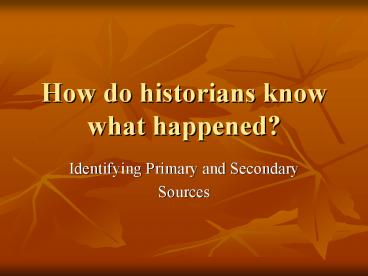How do historians know what happened PowerPoint PPT Presentation
1 / 15
Title: How do historians know what happened
1
How do historians know what happened?
- Identifying Primary and Secondary
- Sources
2
Primary and Secondary Sources
- Historians use a wide variety of sources to
answer questions about the past. In their
research, history scholars use both primary
sources and secondary sources. Primary sources
are actual records that have survived from the
past, such as letters, photographs, articles of
clothing. Secondary sources are accounts of the
past created by people writing about events
sometime after they happened.
3
Samples of Primary and Seconday Sources
- For example, your history textbook is a secondary
source. Someone wrote most of your textbook long
after historical events took place. Your textbook
may also include some primary sources, such as
direct quotes from people living in the past or
excerpts from historical documents.
4
Clues to solve the mystery in history!
- People living in the past left many clues about
their lives. These clues include both primary and
secondary sources in the form of books, personal
papers, government documents, letters, oral
accounts, diaries, maps, photographs, reports,
novels and short stories, artifacts, coins,
stamps, and many other things. Historians call
all of these clues together the historical record.
5
Daily Historical Records
- The historical record is huge. It contains
literally billions of pieces of evidence about
the past. Despite its huge size, the historical
record gives us just a tiny glimpse of the past.
Most of what happened in the past was never
documented. Many sources of information about the
past have been lost or destroyed. Some primary
sources were accumulated simply by accident. - But some historical sources were created and
saved by people interested in recording history.
People kept journals, wrote diaries and
autobiographies, recorded family trees, and saved
business and personal letters and papers. - How can the historical record be both huge and
limited? What kind of historical records do you
leave behind in your daily life?
6
How can the historical record be both huge and
limited?
- To find out about the limitations of the
historical record, do the following activity
- Think about ("mind walk" through) all the
activities you were involved in during the past
24 hours. List as many of these activities as you
can remember.
7
For each activity on your list, write down what
evidence, if any, your activities might have left
behind. To help you think of traces that might be
left behind, review
- Did you create any records of your activities (a
diary, notes to yourself, a letter to a friend or
relative, an e-mail message, a telephone message,
or a grade in school)?
8
Review your entire list, and what you wrote about
evidence your activities left behind. Then answer
these questions
- Which of your daily activities were most likely
to leave trace evidence behind? - What, if any, of that evidence might be preserved
for the future? Why? - What might be left out of an historical record of
your activities? Why? - What would a future historian be able to tell
about your life and your society based on
evidence of your daily activities that might be
preserved for the future?
9
Now think about a more public event currently
happening (a court case, election, public
controversy, law being debated), and answer these
questions
- What kinds of evidence might this event leave
behind? - Who records information about this event?
- For what purpose are different records of this
event made?
10
Primary Source for the Revolutionary War
- A map of Philadelphia and parts adjacent with a
perspective view of the State-House / by N. Scull
and G. Heap L. Hebert sculpt.
11
George Washingtons Journal
12
Painting of George Washington presenting at the
signing of the Constitution, 1787
13
Revolutionary War Spy Letters
- This letter was captured to help locate George
Washington. 1781. - New Windsor May 29, 1781 / Sir, / A day or two
ago I requested / Col. Harrison to apply to you
for a pair / of Pincers to fasten the wire of my
teeth. --I hope / you furnished him with them.--
I now wish / you would send me one of your
scrapers / as my teeth stand in need of cleaning,
and / I have little prospect of being in
Philadelph. / soon.-- It will come very safe by
the Post-- / in return, the money shall be sent
so soon as / I know the cost of it.-- / I am Sir
/ Y Very H Serv Your Very Humble Servant / G.
Washington
14
Identify primary and secondary sources
- Many web sites are useful in locating primary
sources. Be sure they are truly real!
(authentic) - The Library of Congress provided the information
used in this power point presentation. - In the computer class you will be identifying
good authenic primary sources of the Declaration
of Independence.
15
(No Transcript)

